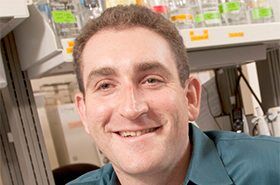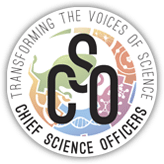Jeremy Babendure, Ph.D., is the Executive Director, Arizona SciTech Festival & Arizona Technology Council Foundation
He’s also an Assistant Research Professor at the ASU School of Molecular Sciences. Jeremy works to develop the Chief Science Officers program, which engages youth in STEM education and personal growth opportunities. Jeremy was recently selected to participate in LEAD STEM, a leadership development program for promising leaders in the STEM fields.
 What drew you to work in the STEM education field?
What drew you to work in the STEM education field?
My undergrad degree is in biochemistry. I have a doctorate in biomedical science, with training in molecular sensors. I was fortunate to work with Roger Tsien, Nobel Laureate, on fluorescent proteins. We had such excitement as scientists, and we wanted to get the work out into the community. We developed some outreach opportunities to help kids and community get immersed in what we did. A lot of my work now is based on similar principles.
How do you see programs in the Arizona SciTech Ecosystem helping solve the employment gap and meet demand for STEM jobs?
We provide tangible programs for the public and students. In addition to the CSO program, we have a huge SciTech Festival that excites and informs Arizonans about how STEM will drive the state for the next 100 years. We’re building awareness about what’s happening in the community and what the needs are. It’s important that corporations and organizations in the workforce arena are seeking to be part of the solution, not just recognizing that STEM education is an important cause.
How are the Arizona SciTech Ecosystem and the CSO program benefitting from involvement in STEM Ecosystems?
It’s great to have a directed place where we can identify and recruit organizations that are the right fit to take on CSO program. Over the past year, we’ve made great connections with other Ecosystems at the in-person Convenings. In the spring, we led a panel discussion about the CSO program and how it works. We brought two of the teenaged CSOs to the next meeting, and they answered questions and discussed their experience with other attendees. Several of the Ecosystems have approached me about wanting to adopt the CSO program in their area. The Ecosystems initiative is the perfect place to not just talk about this national coalition, but to build it along with other Ecosystems.
Moving forward, for the CSO program, we’re working on (1) solidifying processes of the program to make it easier for others to implement; (2) growing to about 1,000 well-supported CSOs in Arizona; (3) growing the program not just in the U.S., but internationally as well.
What’s the most fun and/or rewarding part of your job?
I really enjoy seeing others take a seed of an idea and innovate it. For example, Adrianne Cole is in the Michigan Ecosystem. She saw the CSO idea and ran with it. She’s started her own CSO program and is now a collaborator.
I’ve had a lot of mentors in my life. Loren Thompson took me under his wing to help me when I was building programs and learning to write grants. He also provided guidance and encouragement when I received the grants and was working to implement programs. My doctoral advisor, Roger Tsien, was a phenomenal person, both in his way of thinking about things and his standard of excellence. Steve Zylstra is currently helping me refine skills on building collaborators and coalitions. And if you go way back, my eighth grade Shop teacher. He was down-to-earth, and I loved the hands-on activities. He was just a fun guy to hang out with, always there for the kids to talk to and connect with.
Now that you know all about Jeremy, be sure to read a little more about the Chief Science Officers program. And check out this profile of Chief Science Officer Dana, a senior in high school.


